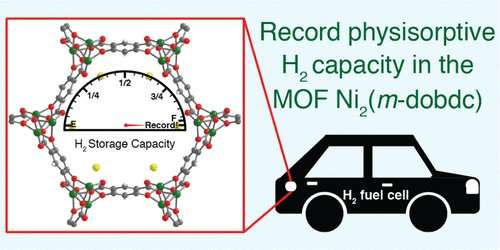Paving the way for more efficient hydrogen cars

Hydrogen-powered vehicles emit only water vapor from their tailpipes, offering a cleaner alternative to fossil-fuel-based transportation. But for hydrogen cars to become mainstream, scientists need to develop more efficient hydrogen-storage systems. Now, researchers reporting in ACS' Chemistry of Materials have used metal-organic frameworks (MOFs) to set a new record for hydrogen storage capacity under normal operating conditions.
According to the U.S. Department of Energy, in 2017 the U.S. had 34 publicly accessible hydrogen fueling stations, with 31 of these in California. Along with increased fueling infrastructure, technological advances are needed for the widespread adoption of hydrogen cars. In particular, improved hydrogen storage systems could increase the driving range of the automobiles while reducing cost. Current hydrogen cars use expensive, bulky cooling or compression systems to store enough hydrogen for acceptable driving ranges. Jeffrey Long and colleagues wondered if they could use MOFs to store more hydrogen fuel under normal driving conditions. MOFs are compounds that contain metal ions coordinated to organic ligands. The 3-D structures of some MOFs form pores that strongly adsorb molecules of hydrogen gas and cause them to attract other molecules, which could allow the gas to condense under near-ambient conditions.
To determine the best MOF for hydrogen storage, the researchers tested four different compounds—two that contained nickel and two that contained cobalt as the coordinating metal. A MOF called Ni2(m-dobdc) showed the highest hydrogen-storage capacity over a range of pressures and temperatures. At ambient temperature and a much lower tank pressure than used in current hydrogen vehicles, Ni2(m-dobdc) set a new record for hydrogen storage capacity of 11.9 g of fuel per liter of MOF crystal. The MOF had a significantly greater storage capacity than compressed hydrogen gas under the same conditions. When the researchers examined the structure of the MOF by neutron diffraction, they found that a single pore contained seven specific binding sites for hydrogen gas that enabled dense packing of the fuel.
More information: Matthew T. Kapelewski et al. Record High Hydrogen Storage Capacity in the Metal–Organic Framework Ni2(m-dobdc) at Near-Ambient Temperatures, Chemistry of Materials (2018). DOI: 10.1021/acs.chemmater.8b03276
Journal information: Chemistry of Materials
Provided by American Chemical Society




















